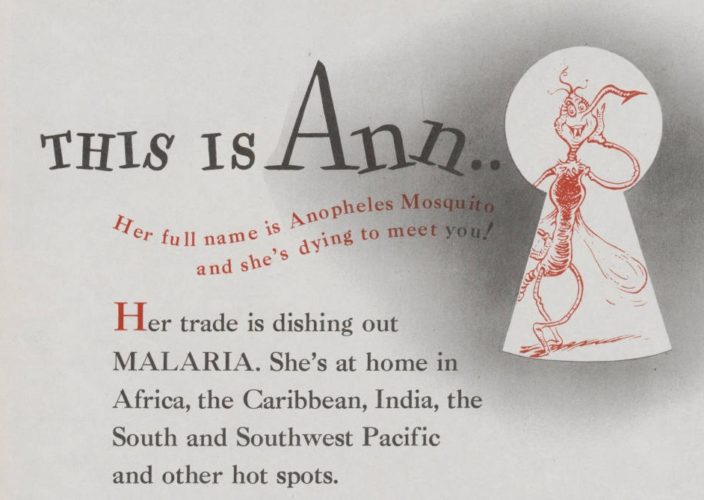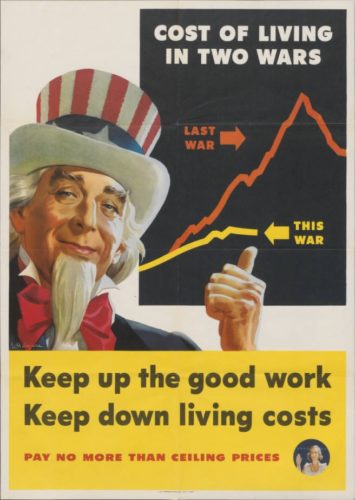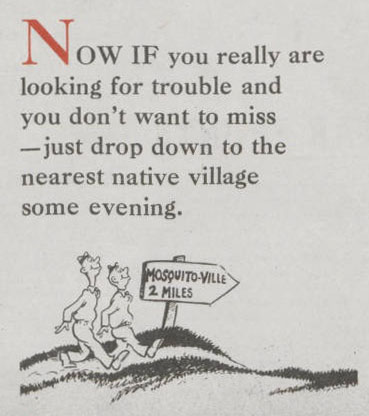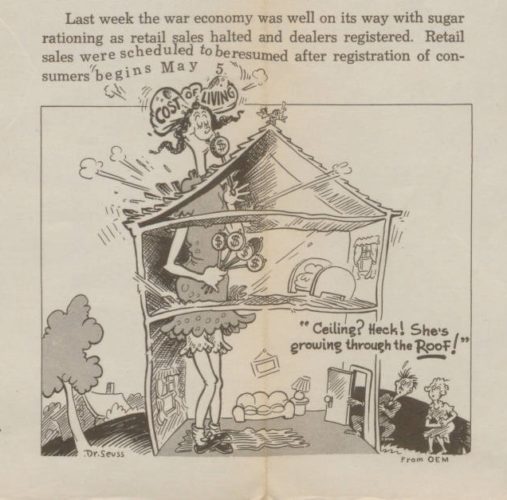“The Pain Became Too Acute, and I Had to Do Something About It”: The Wartime Propaganda of Dr. Seuss

In past blog posts, we’ve shared pieces of WWII propaganda, from posters to pamphlets to materials targeting residents of countries outside the United States. Propaganda was used widely to drum up support for the war effort, both at home and abroad; to remind Americans to preserve scarce materials for soldiers; and to educate soldiers. The iconic artwork of many of these pieces was frequently created by familiar artists, one of whom celebrated a birthday today: Theodore Geisel, more commonly known as Dr. Seuss.
Theodore Seuss Geisel was born on March 2, 1904, in Springfield, Massachusetts. He attended Dartmouth College, where he worked as editor-in-chief for the school’s humor magazine. It was here that he began using his pen name, Dr. Seuss, after being banned from extracurricular activities for violating prohibition; by using a pen name, he was able to continue his work on the magazine undetected. It was also here that he honed his skills as an artist and humorist.

In 1927, Geisel sold his first nationally-published cartoon to the Saturday Evening Post, and followed this success with a move to New York and a job as a writer and illustrator for the humor magazine Judge. His popularity grew, and soon he was drawing advertising for a number of companies and writing a comic strip, Hejji, followed by his first book, And to Think That I Saw It on Mulberry Street.
Geisel enlisted in the U.S. Army in 1943, but by this time he had been creating anti-Nazi and anti-Japanese propaganda for two years, as well as developing material that was strongly pro-war. Though he was an established children’s book author, he felt compelled to comment on the war via his illustrations; in fact, while he was working on Horton Hatches an Egg, a radio news flash led him to pick up his pen: “While Paris was being occupied by the clanking tanks of the Nazis and I was listening on my radio, I found that I could no longer keep my mind on drawing pictures of Horton the Elephant.” His subsequent attacks targeted Hitler and Mussolini as well as Japanese Americans and Charles Lindbergh, whose isolationist views led Geisel – now using the pen name Dr. Seuss full-time – to depict him as an ostrich. Much like other propaganda at the time, the work of Dr. Seuss was what modern viewers would consider to be extremely racist; one such cartoon featured Japanese Americans waiting in line for blocks of dynamite and “the signal from home.” Some of Seuss’s other work, however, was meant to lighten heavy topics, such as his illustrations in training manuals or war posters.

It is two of these war posters, or Newmaps, that we would like to share with our visitors to Ohio Memory. Newsmaps were a one- or two-sided poster that provided updates on the progress of the war, and its effects at home, to American military personnel. Seuss’s iconic style is immediately recognizable in the characters on these posters: one, a mosquito named Ann, and the second, a cartoon commenting on the rising cost of living. Ann (anopheles mosquito) is featured on the November 8, 1943, two-sided Newsmap (please note that, in the link above, this Newsmap will be shown as the second and third items; click on each small image – the thumbnail – and a larger image will display in the viewer). She is a carrier of malaria who is a “real party gal,” who moves at night and who has a thirst for the blood of every G.I. stationed in tropical climates. “She can make you feel like a combination of a forest fire, a January blizzard, and an old dish mop,” the poster tells service members. They are also warned to stay away from local villages: “If there wasn’t enough trouble waiting for you there already” – meaning local girls and other dangerous pursuits – “good old Ann would take care of you and make sure you got fixed up fine – for keeps.”

The second Newsmap, dated May 4, 1942, is one-sided and includes an Army Orientation Course; a color-coded world map, showing territories affected by, and participating in, the war, as well as their political affiliations; and eighteen news briefs, illustrated with either photographs or, in the case of a story on the rising cost of living, a cartoon by Dr. Seuss. The cartoon depicts a young girl who has grown to the point that her head is sticking out of the roof of the family’s two-story house, as she eats a lollipop emblazoned with dollar signs and holds four more in her hand. Her parents’ response to this rapid growth: “Ceiling? Heck! She’s growing through the ROOF!” The final lines of the news story are arched over the cartoon, adding a bit of charm to the page. You can access this Newsmap via the same link as the previously-mentioned one, and you will find it by clicking on the first thumbnail in the column on the right side of your screen.
One important note: the files are quite large and may take time to load in your viewer. We hope that you’ll be patient, because the maps are entirely worth the time.
For more information on Dr. Seuss’s work in the war, University of California, San Diego, has provided access to a large number of his political cartoons on their site Dr. Seuss Went to War: A Catalog of Political Cartoons. If you are interested in additional Newsmaps, we hope to add more digital renderings to Ohio Memory soon but, in the meantime, you can view a lovely collection at the University of North Texas. You may also visit the State Library of Ohio in person if you would like to see print copies of the maps, including the ones with the artwork of Dr. Seuss. Finally, The Atlantic featured an excellent article on Dr. Seuss and his wartime activities in January, 2013, which you can find here; incidentally, this article is the source of our blog title.
Thank you to Shannon Kupfer, Digital Initiatives Librarian at theState Library of Ohio, for this week’s post!



Leave a Reply
You must be logged in to post a comment.